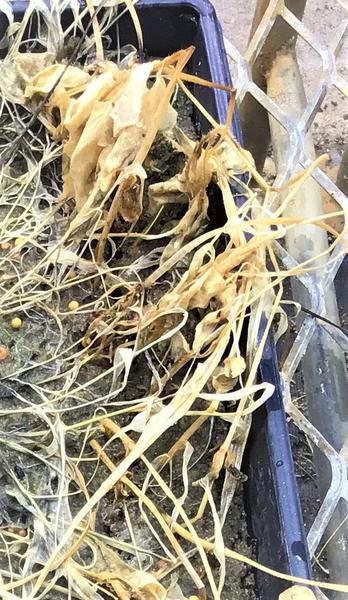Paraquat Injury
- Type
- Physiological
- Leaf Condition
- Complete Necrosis, Brittle, Leaf Spot
- Leaf Location
- Entire, Young, Mature
- Petioles Condition
- Death
- Flowercondition
- Necrotic
- Field Distribution
- Random, Edges
- Prior Environmental
- Wind
- Season
- Early Vegetative
- Cropping System
- Soybean Followed By Soybean, Conventional Till, Reduced Till
Symptoms
Photosystem I-(herbicide group [HG] 22) II-inhibiting herbicides (HG 5) disrupt the photosynthesis process and encompasses many herbicides (e.g. atrazine, metribuzin, and paraquat).
Soybeans are very sensitive to atrazine. Atrazine (HG 5) applied pre- and postemergence is xylem mobile, which results in older leaves exhibiting injury while the new leaves appear healthy. Injury symptomology includes necrosis of the leaf margins, chlorosis and plant stunting. If atrazine persists in the soil at a high enough dose, soybeans may die before emergence. Labeled rotation and soil type-rate restrictions should be followed to avoid injury on soybeans following a crop where atrazine was applied.
Metribuzin affects plants in the same manner as atrazine. The injury caused by atrazine and metribuzin (HG 5) are often indistinguishable. However, metribuzin injury will likely only be evident on emerging soybeans as this herbicide is applied pre-emergence. Some soybean varieties are more sensitive to metribuzin; applied rates may have to be adjusted based on variety being planting. Soil type can also influence the level of metribuzin available to emerging plants which can cause injury to soybeans. Metribuzin will be more available in lighter (i.e. sandy) soils compared to heavier (i.e. loamy) soils. Metribuzin rates may have to be adjusted based on soil types.
Paraquat (HG 22) is a non-selective, contact herbicide. Injury symptomology includes necrosis where the spray droplet lands on the leaf. Low doses of paraquat will result in ‘peppered’ leaves where droplets landed, while high doses will result in necrosis of entire plant (plant death) (Figure 1). Injury and/or plant death from paraquat will occur within several hours of application.
Management
Labeled application and rotation restrictions should be followed to avoid atrazine carry over on soybeans. Metribuzin rates may need to be adjusted to avoid soybean injury if planting certain varieties or planting on certain soil types. Physical drift can be avoided by spraying when the average wind speed is less than 10 miles an hour and mid-day or –afternoon to avoid a temperature inversion.



